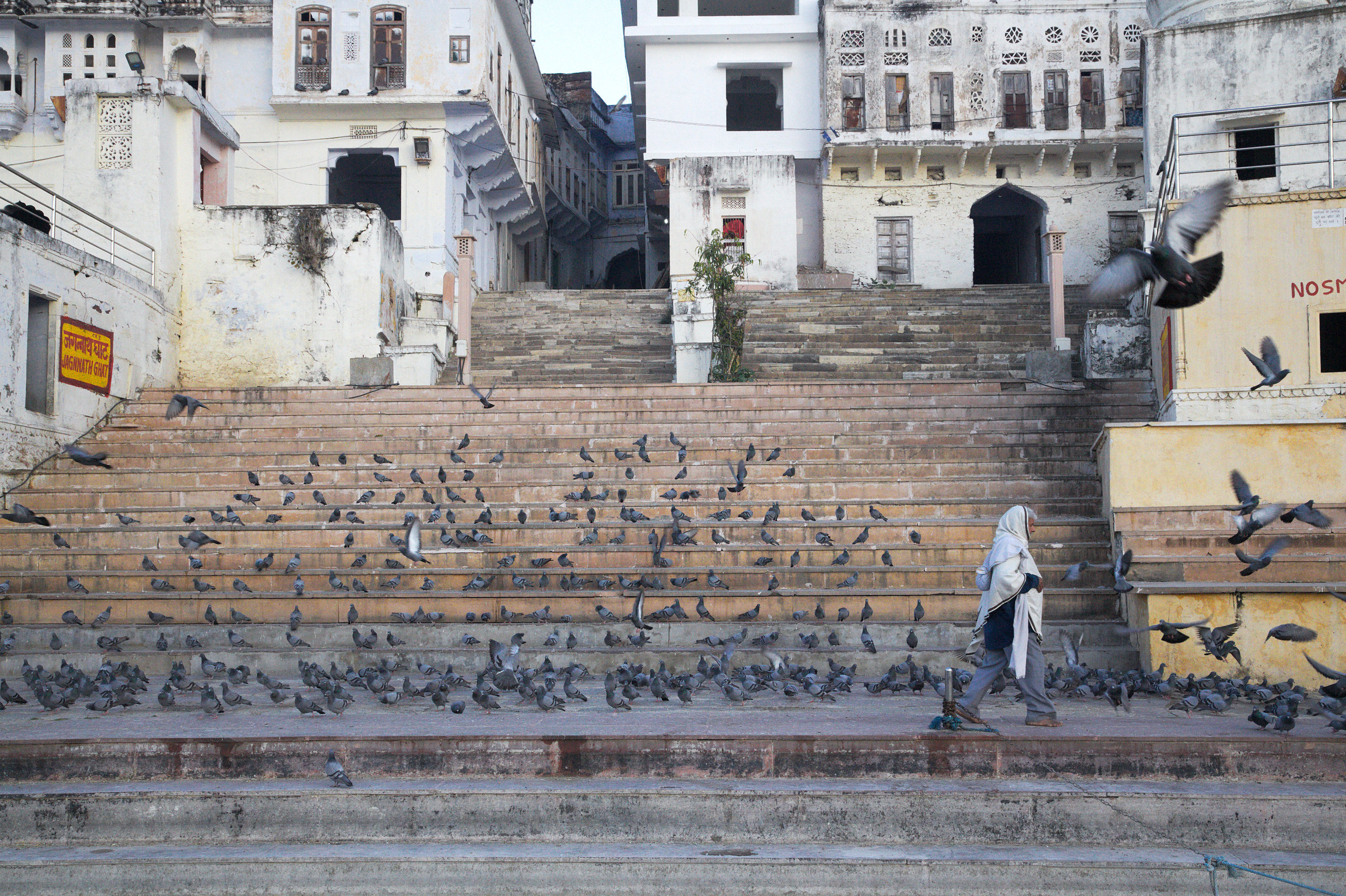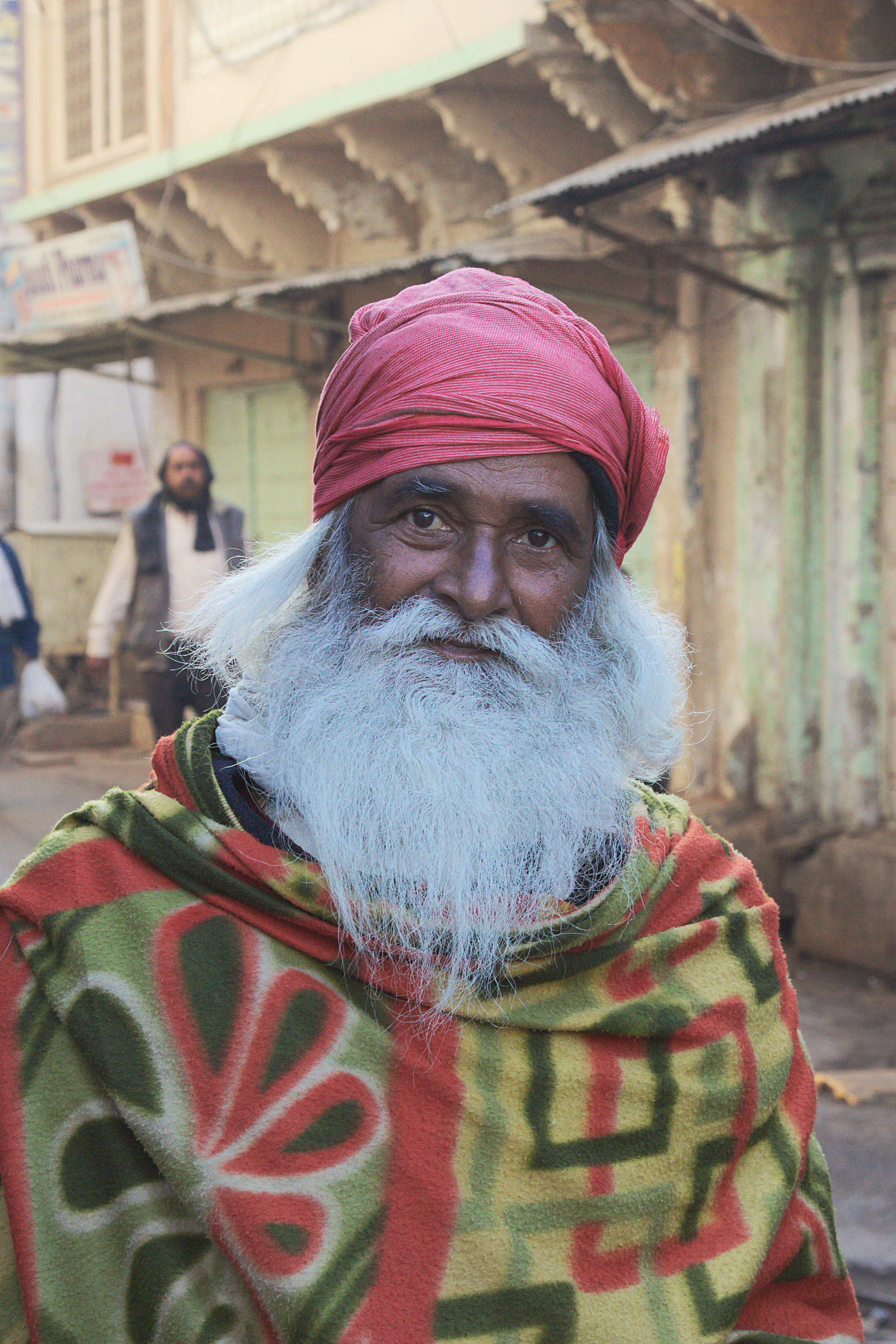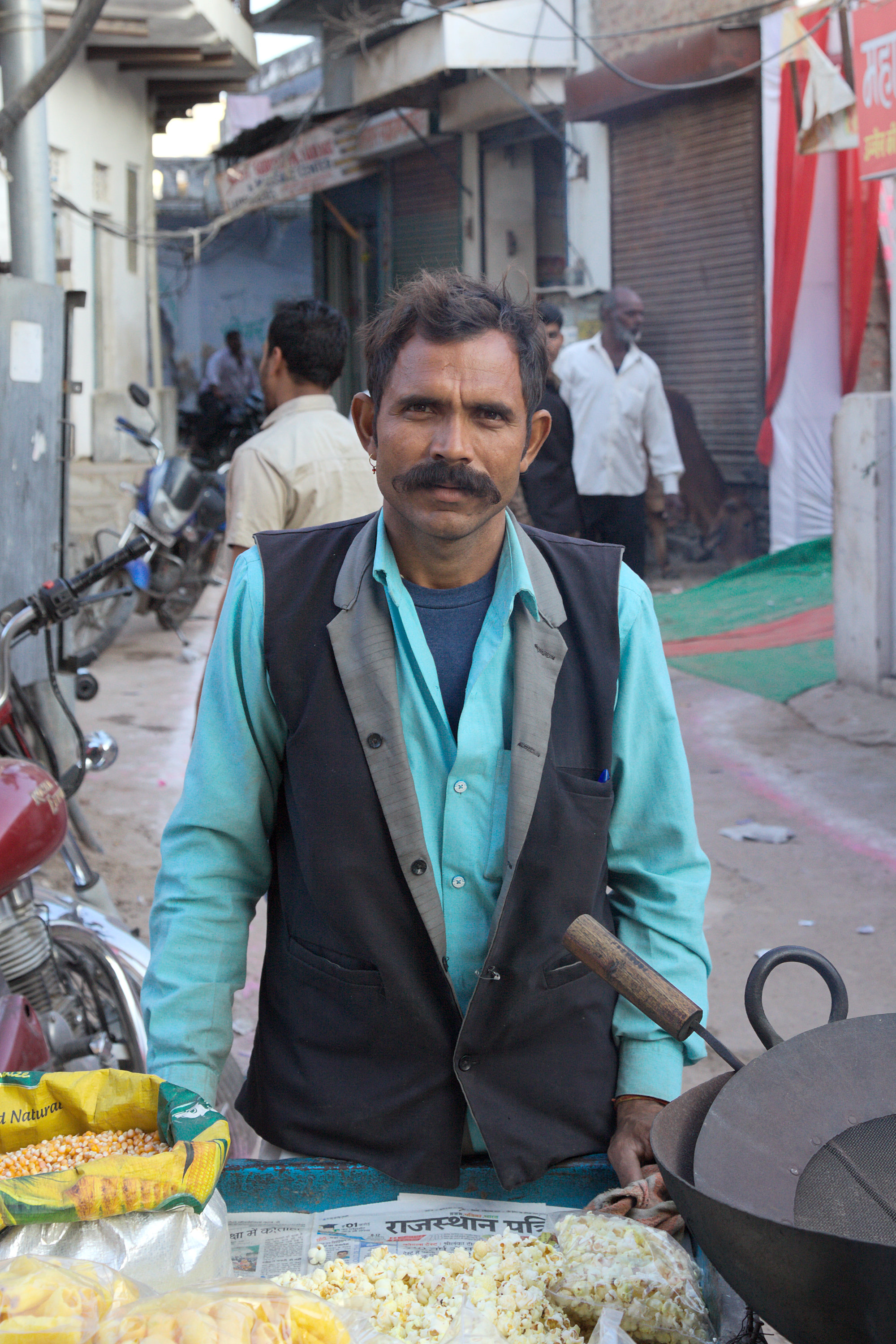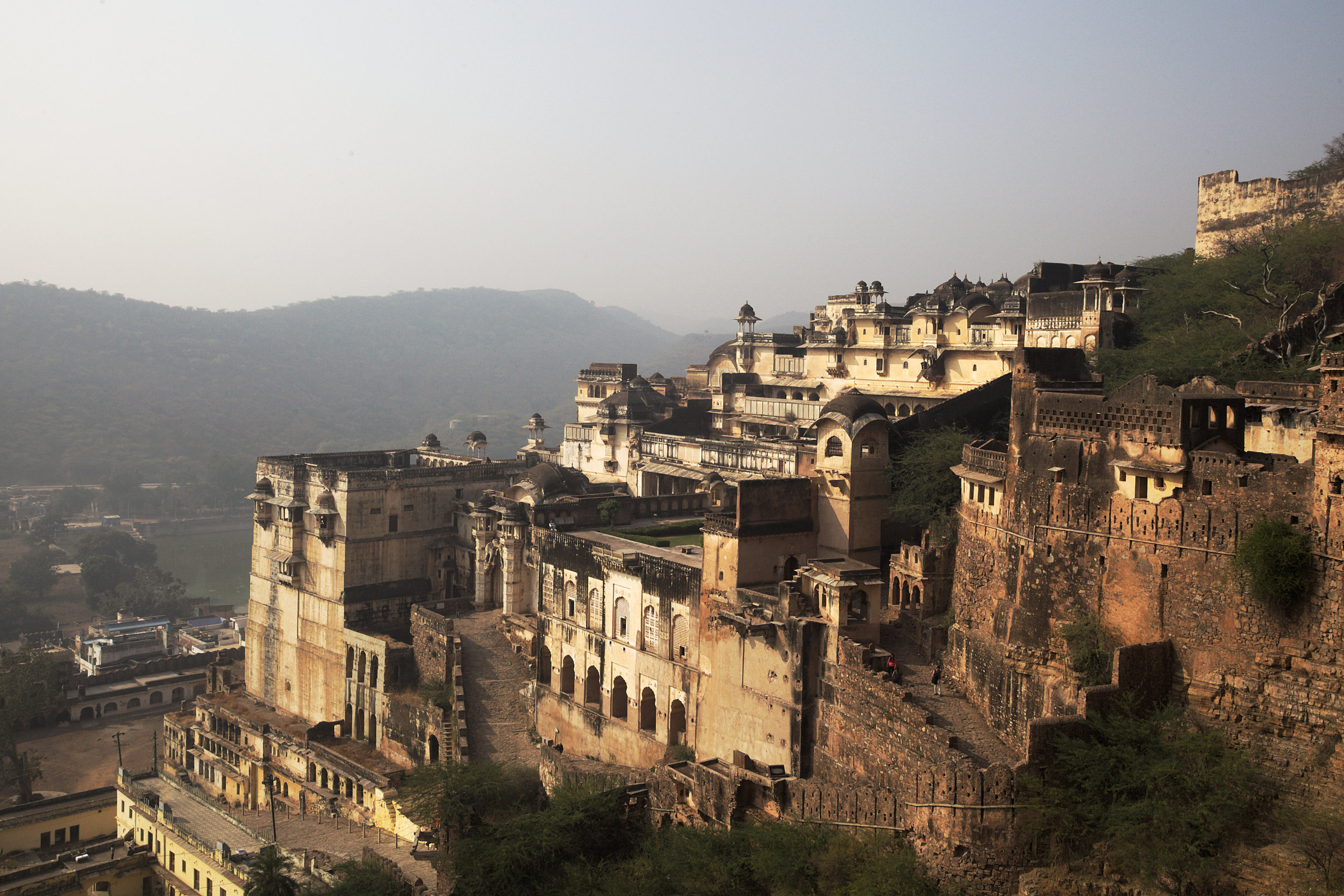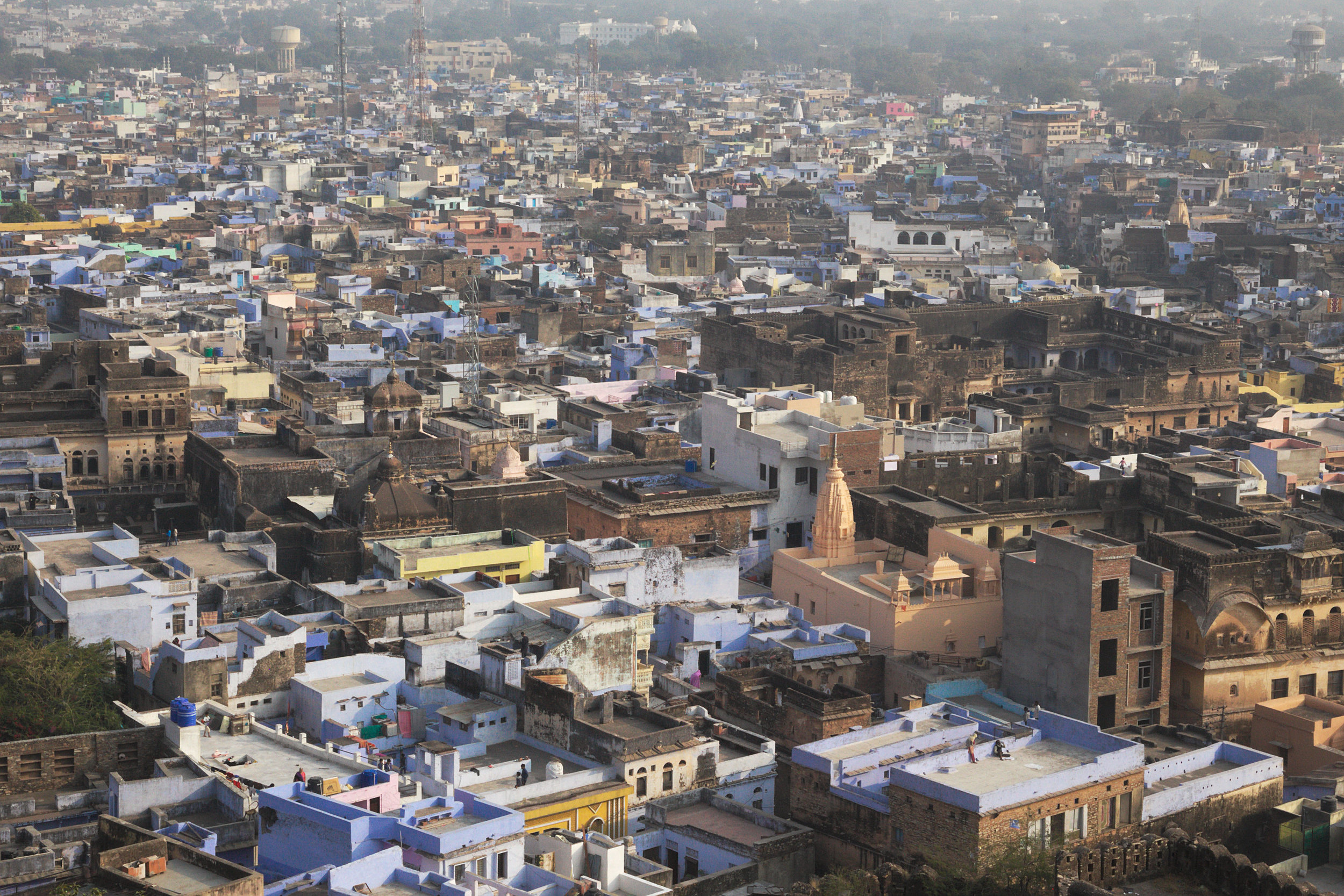‘Ram Ram, Jesheri Ram.’ It was on those Pushkar mornings I first noticed the Hindu god’s Rama’s name being used in greeting. From elderly, turbaned farmers in long white cotton shirts delivering milk in brass containers, to lads in skinny jeans sporting the latest hairstyles, this was the universal greeting. I had journeyed to this Rajasthani town to escape the Himalayan winter and bathe my stiff limbs in the continual golden sunlight. As I sat at a street-stall drinking my first morning chai, I watched the Brahmin priests scurry past the crumbling havelis (Indian townhouses) and slowly the spiritual nature of Pushkar started to reveal itself to me.
A ghat, early morning, in Pushkar
A Pushkar baba
A small town in the Ajmer district of Rajasthan, Puskar is an important pilgrimage site for both Hindus and Sikhs. References in the ancient Indian epic poems, the Ramayan and the Mahabharata, and inscriptions on 4th century BC Greek coins, suggest a long history as a significant religious centre.
Pushkar Lake was created, according to Hindu scriptures, when Brahma dropped lotus flowers to earth while slaying an evil demon. It is surrounded by 52 bathing ghats (steps leading down to the lake) and the domes of hundreds of temples in all shades of cream, white, blue and pink. Most only date to the 18th century as the Moguls destroyed the majority of earlier structures. Religion is life here, and it is also business; every year hundreds of thousands of pilgrims visit Pushkar, the most important site of Brahma worship in India, to pray at the Jagatpita Brahma temple, and take a purifying bath in the lake.
Pushkar is often described as having the only Brahma temple in India. While a quick internet search reveals a handful of others, the one in Pushkar is undoubtedly the most famous. There are many theories as to why Brahma is not widely worshipped among Hindus, particularly when compared to Shiva and Vishnu, the other members of the supreme trio. I find the story of Savitri, Brahma’s first wife, most compelling. One day Brahma was to perform a religious ritual which required the god’s wife to be sat next to him. Savitri wasn’t around on the chosen day so Brahma took a second wife, a Gujjar girl called Gayatri. Savitri arrived back to find Gayatri in her place, and enraged, she cursed Brahma so he could only be worshipped in Pushkar. Today, Savitri’s and Gayatri’s temples are positioned at opposite ends of the lake: Savitri sits angrily on top of the hill at the western end, looking down on Brahma, while Gayatri cowers from Savitiri’s wrath in her more simple dwelling on a lower hill.
Lakeside in the afternoon sun
Daily activity in Pushkar centres around the ghats and the warren of tunnels and passageways leading from the narrow market streets to the lake. Groups of villagers, wrapped in blankets, fall out of small mini-buses, and stumble down the ghat steps before the stones have been warmed by the rising sun. Despite the holiness of this place, the lake could not be described as clean. Pigeon and cow excrement cover the steps, and broken Shiva lingums and pieces of Ganesh, Shiva’s elephant-headed son, are scattered everywhere. In the hot hours of the day, small turtles emerge onto the concrete bank to escape the murky green waters.
Most bathers however, fully submerge themselves in the lake eager to take full advantage of the water’s special healing properties. Men emerge in glistening black underpants and the reds, yellows and oranges of women’s wet saris create a colourful border. Worshippers often ask a Brahmin priest to bless their family members, for a fee of course, leaving magenta flower petals floating on the green. Lone Brahmins sit in cubby holes chanting mantras, and groups sit together on the ghats performing ceremonies, casting long shadows in the late afternoon sun.
The popcorn seller
For me, the lake at sunrise and sunset is particularly magnetic. The Sanskrit chanting of the aartis fill the still evenings, along with beating drums and clanging bells. During an aarti, burning ghee is slowly circled in the air by a Brahmin at the lakeside, accompanied by songs in praise of the worshipped deity. After a certain point the flame is believed to take on the power of the god and worshippers line up to put their hands on it before touching their head in a purification ceremony. I visited the evening aarti several times attracted by the intensity of the proceedings. As the aarti progresses the crowd whips itself up into a frenzy which concludes with the worshippers shouting the names of their gods in unison, like fanatical football supporters.
For me, Pushkar emphasised the level of devotion among Hindus to their gods, and also the extent to which it is intertwined with their daily lives. With the Abrahamic religions it appears that worshipping revolves around a specific place, to some extent separating it from daily life and work. In India, Hindu shrines are everywhere: in every home, every shop, every café, every hotel, every street corner. On many occasions I have had to wait for a chai-wallah to finish his puja before I can get my chai. Hinduism fits in, it is a way of life and it is very much alive.
Pushkar mornings
After Pushkar, I moved onto another small Rajasthani town called Bundi where I was to witness ‘Ram Ram. Jesheri Ram’ being used in a very different way. Bundi was one of the Rajput kingdoms that appeared in Rajasthan between the 6th and 13th centuries, all of which were eventually to be conquered by the Moghuls. It is overlooked by an impressive palace which was built by the Rajput ruler Rao Ratan Singh in the 16th and 17th centuries. I visited to explore its impressive collection of stepwells and kunds, structures unique to India which were used to catch and store ground and rain water. What I unwittingly walked into however, was a town embroiled in religious unrest.
In 1942, on a hill outside Bundi, a cenotaph commemorating war heroes was destroyed after it was damaged by lightening. It is said a worker saw an effigy of the Hindu god Hanuman on one the damaged pillars prior to demolition, and in April 2017 local Hindu groups tried to erect a replacement statue of Hanuman on the same hilltop. This cenotaph however, is very close to Meera Datar, an important Muslim shrine. Bundi’s Muslim population is significant at around 21% and prior to this attempted construction, the Muslim community protested. Eventually a local court ruled that the action was inflammatory towards the Muslim population and imposed restrictions on Hindus visiting the site.
Bundi palace
Not having free and unrivalled access to religious sites, of which they are an almost infinite number, greatly riles Hindus. Perhaps the most famous dispute was over the Babri Masjid (mosque) in the town of Ayodhya in Uttar Pradesh which stood on what is believed to be the birth-place of Lord Rama. In 1992, after a long build-up fuelled by Hindu political organisations, this mosque was demolished by Hindu ‘volunteers’, triggering communal riots across India which led to over 2000 deaths.
Bundi town
Blues in Bundi
The day after I arrived in Bundi, local Hindu groups, in protest over this court order, had planned a procession from Bundi town to the site of the cenotaph. Newspaper reports suggested that this march was being led by the right-wing Hindu nationalist political party, the Hindu Mahasabha which was set up in 1915 to protect the rights of Hindus in India, after the formation of the All India Muslim League in 1906. It identifies India as a Hindu nation, regarding Sikhs, Jains and Buddhists as Hindus in different guises and considers Indian Christians and Muslims as being Hindus that have been forcibly converted to foreign religions. Its political influence has remained marginal, and when six of its prominent members were convicted of assassinating Mahatma Gandhi, its influence further declined. However, it remained active as a Hindu organisation and it appears to weld a reasonable level of influence on communities, particularly in rural areas.
In the religious tinderbox of India, the police quickly moved in to halt the procession and shut off the internet to prevent news spreading. The protestors pelted the police with stones and set fire to police vehicles. Meanwhile, the police responded with lathi-charging (lathi-charging is a word I have only read in the Indian press - lathi means stick in Hindi) and detained two leading babas (holy men). Many protestors were hurt and dozens more arrested by police, the numbers of which varied widely between different newspaper reports.
A vegetable seller in Bundi
The following day I was told ‘the babas are coming’ from other areas of Rajasthan to join their holy brethren in this struggle. There was also a bandh (strike) in the town as Hindu shopkeepers closed (or were ordered to close) in protest at the arrest and injuries. A few chai-wallahs tentatively raised their shutters, as chai drinking must continue in all circumstances, but otherwise the markets were deserted. Public services, including the government bhang shop, remained open. I learned that day, as I watched the mixing of a nauseating dark green bhang lemonade, that bhang is the male marijuana plant and should be drank or eaten. After expressing his disbelief that bhang was not legal in my country, the bhang-wallah told me cheerily that today he was doing great business. ‘Normally we are all on our phones and not talking to each other. But today we are talking and taking full enjoy!’
This was my only piece of entertainment however, in a town where the atmosphere had rapidly turned sinister. Groups of youths screeched around on motorbikes, flaunting Hindu flags, provocatively shouting ‘Ram Ram, Jesheri Ram’. On the streets I had to avoid burning tyres and groups of men hanging around. ‘All Muslims are from Pakistan’ one man told me. ‘They are trying to breed us out and take over the world.’
By the evening a local government van patrolled the streets blasting orders through a loud-speaker for shopkeepers to resume business. This appeared to carry little weight and after two days of tension, I decided to leave Bundi. I departed with the shops still shut and the internet still off. After I left I could find little in the national press as to how, or if, the situation had been resolved.
My encounters in Rajasthan left me in no doubt as to the importance of Hinduism in India. There is no visible wavering in the levels of devotion displayed towards the Hindu deities, with the young exhibiting similar levels of zeal to that of the older generations. I also sensed a threat to the precarious peace between Hindus and Muslims in India, and a warning that the fire of religious unrest and violence could be set alight at any moment.
Bundi door
Kund in Bundi - used to collect and store ground water

